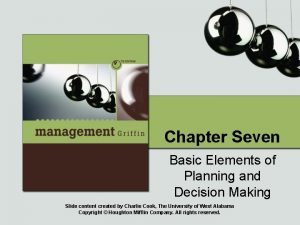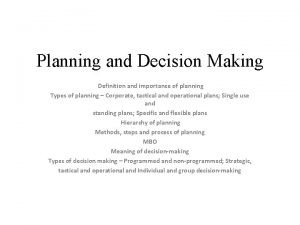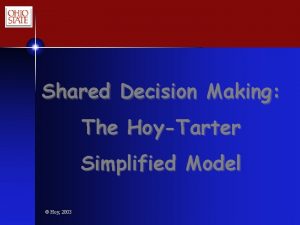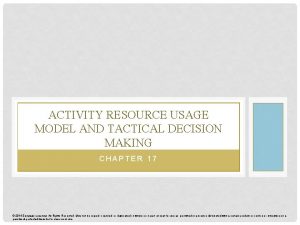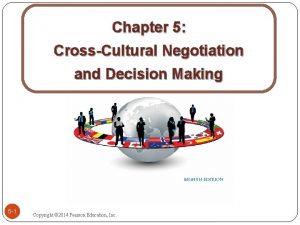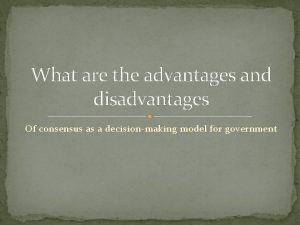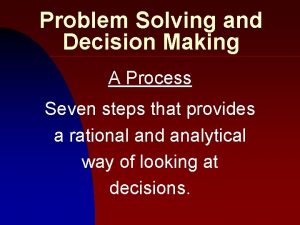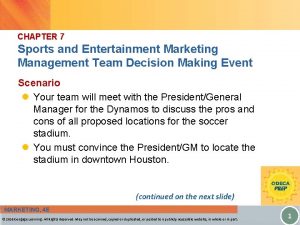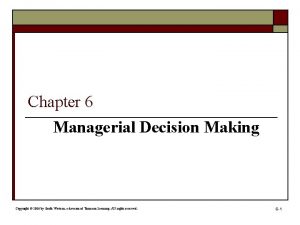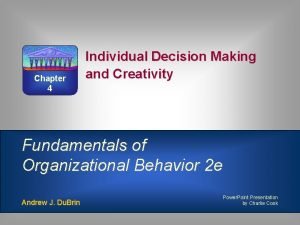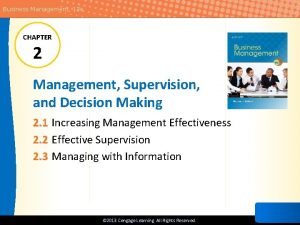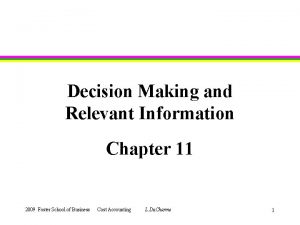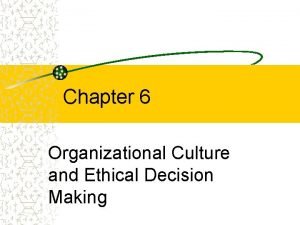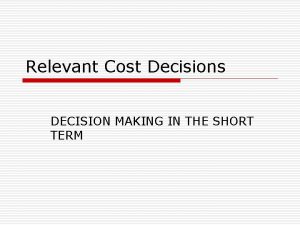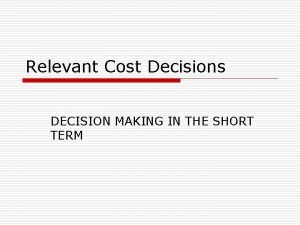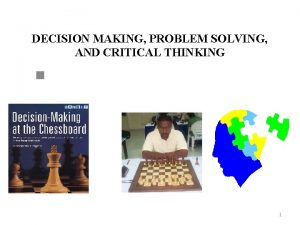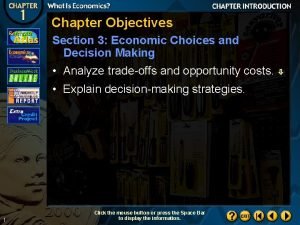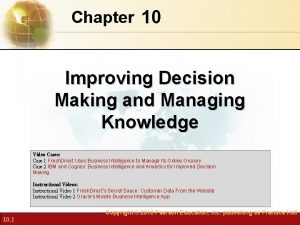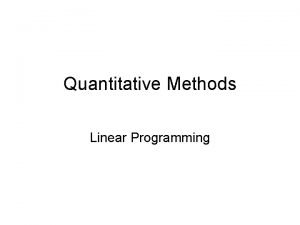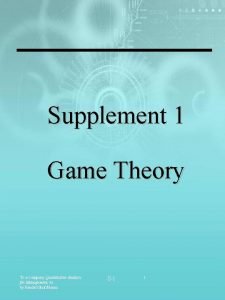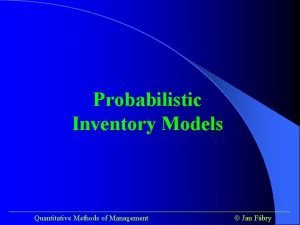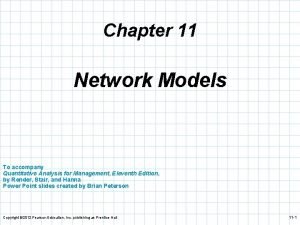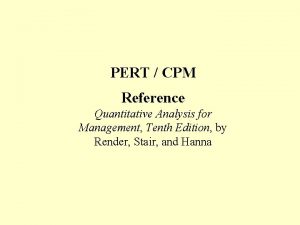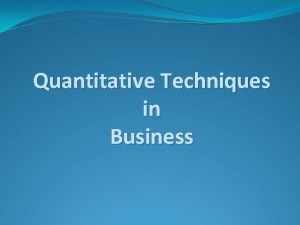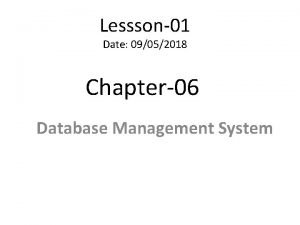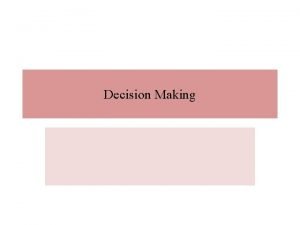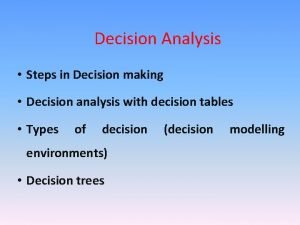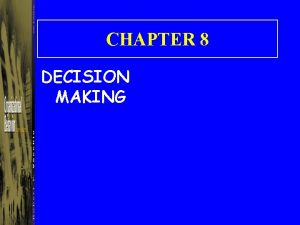CHAPTER06 QUANTITATIVE TECHNIQUES FOR PLANNING AND DECISION MAKING


























































- Slides: 58

CHAPTER-06 QUANTITATIVE TECHNIQUES FOR PLANNING AND DECISION MAKING 1 Dr. Gehan Shanmuganathan, (DBA)

CATERPILLAR INC. . 2

CATERPILLAR INC. . Managed raw materials based on quantitative techniques � Minimum � Demand order quantity management 3

CHAPTER OBJECTIVES 4

6. 1 LEARNING OBJECTIVES 1 Explain how managers use data-based decision making 2 Explain the use of forecasting techniques in planning. 3 Describe how to use Gantt charts, milestone charts, and PERT planning techniques. 4 Describe how to use break-even analysis and decision trees for problem solving and decision making. 5 Describe how to manage inventory by using materials requirement planning (MRP), the economic order quantity (EOQ), and just-in-time (JIT) techniques. 6 Describe how to identify problems using a Pareto diagram

DATA- BASED DECISION MAKING 6

DATA- BASED DECISION MAKING Data-Driven �An Management (DDM) attitude and approach to management rather than a specific technique that stems from data-based decision making 7

WHERE MANAGERS USE DATA-BASED DECISION MAKING? How much to invest? Buy or make decisions? Market size, demand, and potential? Number of employees needed? Sales targets? Quality controls? Cost controls? Best employees? 8

FORECASTING METHODS 9

FORECASTING METHODS Judgmental Forecasting (usually bottom-up) �A qualitative forecasting method based on a collection of subjective opinions Time-Series Analysis (usually top- down) � An analysis of a sequence of observations (historical data) that have taken place at regular intervals over a period of time (hourly, weekly, monthly, and so forth) Moving average and exponential smoothing 10

7. 2 TYPES OF FORECASTING METHODS Qualitative A prediction based on a collection of subjective hunches. Quantitative A prediction based on historical data or models, such as a time-series analysis. Annual Sales 100 ca e r o F 75 Da d e t s ta 50 25 0 1992 1994 1996 1998 2000 2002 2004 2006 Adapted from Exhibit 7. 2

TIME SERIES ANALYSIS- MOVING AVERAGE 12

TIME SERIES ANALYSIS-EXPONENTIAL SMOOTHING 13

ERRORS AND TRAPS MAKING FORECASTS OR ESTIMATES Over confidence Prudence “to be on the safe side” Credibility of the past figures used Moving average will not take other factors (customers, competitors, and suppliers) into consideration but the given figures to extrapolate 14

TYPES OF FORECASTS 15

TYPES OF FORECASTS Economic forecasting – GDP, GNP, per capita income, consumer confidence, inflation, unemployment Sales forecasting- weekly, monthly, annual, geographically, per salesman, per brand Technological forecasting – number of users, computer literacy, use of e-commerce 16

SCENARIO PLANNING TO MAKE GOOD USE OF FORECAST 17

SCENARIO PLANNING The process of preparing responses to predicted changes in conditions � What the future might look like � Worse and Best case scenario 18

THE DELPHI TECHNIQUE FOR INCREASING THE ACCURACY OF FORECASTS 19

THE DELPHI TECHNIQUE A form of group decision making designed to provide group members with one another’s idea and feedback while avoiding some of the problems associated with interacting groups � Includes series of decision making sessions until they reach the final decision as pre-determined 20

GANTT CHARTS AND MILESTONE CHARTS 21

GANTT CHARTS 22

GANTT CHARTS- HENRY GANTT (SCIENTIFIC MANAGEMENT) A chart that depicts the planned and actual progress of work during the life of the project 23

GANTT CHART: OPENING A NIGHTCLUB Production Activities Jun Jul Aug Sep Oct Nov 01. Locate site 02. Get liquor license 03. Hire contractors for renovation 04. Supervise renovation 05. Hire lighting contractor 06. Supervise lighting installation 07. Begin advertising of club 08. Hire club employees 09. Get booking agent for nightclub talent 10. Open for business Scheduled Completed 30 Nov Dec Jan


MILESTONE CHARTS 26

MILESTONE CHARTS An extension of the Gantt chart that provides a listing of the sub-activities that must be completed to accomplish the major activities listed on the vertical axis 27

7. 4 MILESTONE CHART: OPENING A NIGHTCLUB Production Activities Jun 01. Locate site 1 Jul 2 Sep Oct Nov Dec Jan 3 02. Get liquor license 4 03. Hire contractors for renovation 04. Supervise renovation Aug 4 11 14 15 05. Hire lighting contractor 06. Supervise lighting installation 5 12 16 6 7 9 10 13 17 18 20 19 21 22 07. Begin advertising of club 08. Hire club employees 09. Get booking agent for nightclub talent 10. Open for business 8 27 23 24 25 26 28 29 31 30 32 33 Milestones to be Accomplished 27. Speak to friends and acquaintances about job openings 28. Put ad in local newspapers 29. Conduct interviews with applicants and check references of best candidates 30. Make job offers to best candidates 33. Have grand-opening celebration 5 January Adapted from Exhibit 7. 5

PROGRAM EVALUATION AND REVIEW TECHNIQUE (PERT) 29

PROGRAM EVALUATION AND REVIEW TECHNIQUE (PERT) A network model used track the planning activities required to complete a large-scale, non-repetitive project. It depicts all of the interrelated events that must take place 30

7. 5 PERT NETWORK: OPENING A NIGHTCLUB Estimated Time in Preceding Event Weeks Event Activity A Locate site B Get liquor license 30 A C Hire renovation contractors 13 A D Supervise renovation 30 C E 6 D F Hire lighting installation Supervise lighting installation 13 E G Begin advertising club H Hire club employees I Get booking agent 8 G, H J Open club for business 1 I 5 8 14 None B, F G = Critical Path (thick arrow) Adapted from Exhibit 7. 6

7. 6 PERT NETWORK: OPENING A NIGHTCLUB (CONTINUED) 14 30 H G B 5 8 Start A I 30 13 6 D 1 J 8 13 C 8 F E Adapted from Exhibit 7. 6

EXAMPLE A, B are two activities, B cannot start until A is finished. A takes 5 days and B takes 7 days 1 A 5 days 2 B 7 days 3

EXAMPLE -2 B, C and D cannot start until A is completed 3 B 1 A 2 C 4 D 5

STEPS INVOLVED IN PREPARING PERT NETWORK 35

STEPS INVOLVED IN PREPARING PERT NETWORK 1. Prepare a list of all activities and events necessary to complete the project 2. Design the actual PERT network, relating all the activities to each other in the proper sequence 3. Estimate the time required to complete each activity 36

TIME IN PERT 37

“TIME” IN PERT Expected Time- the time that will be used on the PERT diagram as the needed period for the completion of an activity Critical Path- the path through the PERT network that includes the most time-consuming sequence of events and activities Optimistic Time (O)- the shortest time an activity will take if everything goes well Pessimistic Time (P)- the amount of time an activity will take if everything goes wrong Most Probable Time (M)- the most realistic estimate of how much time an activity will take 38

CRITICAL PATH B 100 0 A 5 5 20 5 3 C 4 30 8 1 0 6 40 9 9 D 5 E F 7 60 16 16 H 8 7024 24 G 50 10 11 5 39

BREAK-EVEN ANALYSIS 40

BREAK-EVEN ANALYSIS A method of determining the relationship between total cost and total revenues at various levels of production or sales activity � No cost- no profit point 41

7. 7 BREAK-EVEN CHART: ADDING A NEW PRODUCT 80 Revenues and costs ($ in thousands) 70 Revenues Break-Even Point 60 Profit Total Costs 50 Variable Costs 40 Loss 30 Fixed Costs 20 Sales (units in hundreds) 10 0 10 20 30 40 50 60 70 80 90 100 Adapted from Exhibit 7. 7

BREAK-EVEN FORMULA-UNITS FC BE = ___________ Unit Selling Price- Unit Variable Cost $ 300, 000 BE = ___________ = 600 Units $ 1, 000 - $ 500 43

DECISION TREES 44

DECISION TREES Decision Tree- A graphic illustration of the alternative solutions available to solve a problem Expected value- the average return on a particular decision being made a large number of times 45

7. 8 FIRST-YEAR DECISION TREE FOR NIGHTCLUB OWNER Possible Alternatives States of Nature Decision Point h Nig h dinn tclub er r and esta ura nt od Go Po or $90, 000 sea son (0. ) o s ea ds o Go Poo Expected Values $100, 000 0. n( o s sea nly o b tclu 6) Conditional Values 6 0. ( n 4) -$10, 000 $150, 000 $120, 000 r se aso n (0. 4 ) -$30, 000

INVENTORY CONTROL TECHNIQUES 47

7. 9 INVENTORY CONTROL TECHNIQUES Material-Requirement Planning (MRP) A system designed to ensure that materials handling and inventory control are efficient. Just-in-Time (JIT) A system designed to minimize inventory and move it into the plant exactly when needed. Economic-Order Quantity (EOQ) The inventory level that minimizes both administrative and carrying costs.

ECONOMIC ORDER QUANTITY (EOQ) The inventory level that minimizes both administrative costs and carrying costs 49

JUST-IN-TIME SYSTEM (JIT) A system to minimize inventory and move it into the plant exactly when needed This is a demand driven pull strategy used at the manufacturing facility Short production lead time High inventory turnover 50

LIFO VS. FIFO LIFO- Last In, First Out Selling an item first that FIFO- First In, First Out Selling an item first that was received last in has been in inventory the longest 51

PARETO DIAGRAMS FOR PROBLEM IDENTIFICATION 52

PARETO DIAGRAMS A bar graph that ranks types of output variations by frequency of occurrence 53

PARETO DIAGRAMS 54

WRITE FIVE KEY THINGS (AREAS) THAT YOU CAN CRITICALLY REMEMBER IN TODAY’S DISCUSSION 55

WHAT WE DISCUSSED TODAY? 56

6. 1 LEARNING OBJECTIVES 1 Explain how managers use data-based decision making 2 Explain the use of forecasting techniques in planning. 3 Describe how to use Gantt charts, milestone charts, and PERT planning techniques. 4 Describe how to use break-even analysis and decision trees for problem solving and decision making. 5 Describe how to manage inventory by using materials requirement planning (MRP), the economic order quantity (EOQ), and just-in-time (JIT) techniques. 6 Describe how to identify problems using a Pareto diagram

MID-TERM TEST –PROGRESS? 58
 No decision snap decision responsible decision
No decision snap decision responsible decision Dividend decision in financial management
Dividend decision in financial management What are the basic elements of planning
What are the basic elements of planning Management chapter 5 planning and decision making
Management chapter 5 planning and decision making Individual and group decision making
Individual and group decision making Management chapter 5 planning and decision making
Management chapter 5 planning and decision making Group decision making techniques
Group decision making techniques Quantitative techniques for economics and management
Quantitative techniques for economics and management Decision table and decision tree examples
Decision table and decision tree examples Using recursion in models and decision making
Using recursion in models and decision making Using recursion in models and decision making sheet 3
Using recursion in models and decision making sheet 3 Chapter 6 prices and decision making assessment answers
Chapter 6 prices and decision making assessment answers Hoy model
Hoy model Decision making and relevant information
Decision making and relevant information Best books on problem solving and decision making
Best books on problem solving and decision making Individual and group decision making
Individual and group decision making Perception and individual decision making
Perception and individual decision making Five step decision making process
Five step decision making process Individual and group decision making
Individual and group decision making Chapter 2 economic systems and decision making answer key
Chapter 2 economic systems and decision making answer key Decision making and branching in c
Decision making and branching in c Horizontal solutions group synergy
Horizontal solutions group synergy What they see
What they see Decision making and goal setting
Decision making and goal setting Chapter 2 economic systems and decision making
Chapter 2 economic systems and decision making Individual and group decision making
Individual and group decision making Activity resource usage model and tactical decision making
Activity resource usage model and tactical decision making Activity resource usage model and tactical decision making
Activity resource usage model and tactical decision making Decision making process definition
Decision making process definition Counter-controlled
Counter-controlled Cross cultural negotiation and decision making
Cross cultural negotiation and decision making Chapter 11 decision making and relevant information
Chapter 11 decision making and relevant information Advantages of consensus
Advantages of consensus Judgement and decision making reasoning
Judgement and decision making reasoning 7 steps of problem solving and decision-making
7 steps of problem solving and decision-making Chapter 2 economic systems and decision making
Chapter 2 economic systems and decision making Scope of decision making
Scope of decision making Sports and entertainment marketing team decision making
Sports and entertainment marketing team decision making Six decision making steps
Six decision making steps Decision making and creativity organizational behavior
Decision making and creativity organizational behavior Chapter 11 decision making and relevant information
Chapter 11 decision making and relevant information Chapter 2 management supervision and decision making
Chapter 2 management supervision and decision making Decision making and relevant information
Decision making and relevant information The role of corporate culture in ethical decision making
The role of corporate culture in ethical decision making The perceived relevance or importance of an ethical issue
The perceived relevance or importance of an ethical issue 5 step decision making process
5 step decision making process Decision making and relevant information
Decision making and relevant information Critical thinking problem solving and decision making
Critical thinking problem solving and decision making The pattern of faulty and biased decision making
The pattern of faulty and biased decision making The pattern of faulty and biased decision making
The pattern of faulty and biased decision making Chapter 1 section 3 economic choices and decision making
Chapter 1 section 3 economic choices and decision making Improving decision making and managing knowledge
Improving decision making and managing knowledge Linear programming in quantitative techniques
Linear programming in quantitative techniques Game theory quantitative techniques
Game theory quantitative techniques Cpm in quantitative techniques
Cpm in quantitative techniques Probabilistic inventory models example
Probabilistic inventory models example Network model in quantitative techniques
Network model in quantitative techniques Tools of quantitative techniques
Tools of quantitative techniques Cpm in quantitative techniques
Cpm in quantitative techniques


